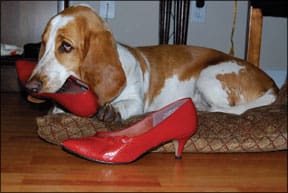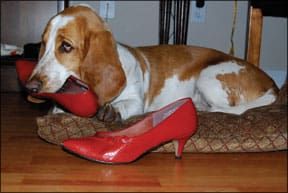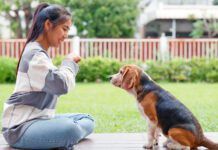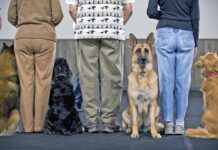For almost any challenging dog event there are at least five relatively easy things you can do to defuse the crisis and reduce the likelihood of a return engagement of the unwanted behavior. “Action Plan” is a new column that will offer five simple solutions for one common undesirable dog behavior. Feel free to suggest your favorites!
Here are five things to do about the dog who chews up your shoes:
1. Breathe
Even if your dog still has your $600 pair of leather Gladiator sandals in his mouth, take three deep breaths to calm yourself. Then grab a high-value treat out of the plastic container of treats that you keep handy in every room of the house – you do, right? – and quietly trade him for the shoe. Tell him he’s a good boy when he gives up the sandal for the treat, and absolutely resist the urge to punish him! You’ll get your shoe back faster, with less damage, if you cheerfully trade for it rather than chasing him around. If you punish him, it’ll be that much harder to get the next shoe back. (See “Thanks for Sharing,” Whole Dog Journal September 2001.)

2. “Dog-Proof”
…the house for items you really don’t want him to chew. Put your shoes in a closet and close the door. It really can be that simple. Often, management is the answer, rather than training.
3. Restrict
Limit your dog to smaller, more dog-proofable areas if you can’t dog-proof the whole house: Prevent your dog’s access to any areas where tempting, chewable footwear might be left lying about. Use baby gates, tethers, doors, and leashes to restrict his activities to dog-proofed areas or, if necessary, to the “right under your nose” zone. (See “Upper Level Management,” October 2001.)
4. Get Him Some Appropriate Chew Things
“Appropriate” means things that are safe, reasonably healthful, and that he likes. If he doesn’t chew what you’ve already bought him, keep searching until you find things he does chew. Not every dog loves hard plastic ersatz bones. Remember that leather shoes are just treated animal hide – not so very different from a cow ear or any of the other animal-parts chewies now on the market. A Pizzle makes a fine alternative to shoe leather. Stuffed Kongs are high on the “appropriate chew things” list. You can create stuffing recipes to tempt all but the most finicky of chewers.
If you have a dedicated chewer get him a black Kong – they are the toughest. Thick raw carrots can also make great chew toys.
5. Increase His Exercise
That’s mental exercise, by the way, as well as physical exercise. Unless you’re walking a marathon, remember that an on-leash walk is a mere exercise hors d’oeurve for a dog. A walk is a nice social outing, but exercise means when you get done he plops to the floor, stretches out on his side, happily panting, for a long nap.
So, it’s a rousing game of fetch, with you standing on top of the hill and tossing the ball down to the bottom. It’s an invigorating round of tug, or an off-leash hike in the hills with your dog running circles around you. Mental exercise is positive training that encourages your dog to think. My personal favorite for mental exercise is shaping. (See “The Shape of Things to Come,” March 2006; and “A Puzzling Activity,” June 2008.)






